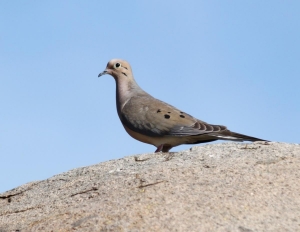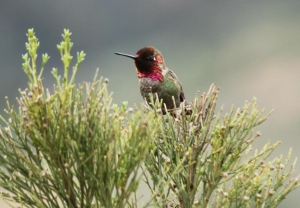
By Greg Dunne
December 19, 2014 (San Diego’s East County)--“Free as a bird.” I might be a bit biased on this subject, being an avid birder, but I believe in the world of nature that birds are the biggest part of our human culture. We eat them, we use them in clothing, they are used for our national symbol, and we use them in our daily language.
My favorite cultural gifts that birds have given to us are bird idioms. What are bird idioms? Idioms are phases or sayings in our language that are separate from the literal meaning. A classic bird idiom is “A bird in the hand is better than two in the bush.”
 This well-known idiom (bird in the hand) means that it is better to keep what you have than to risk losing it by trying to get something better. We use these bird idioms in our daily life without even thinking about them. Most of them have origins dating back several centuries ago. The “bird in the hand is better than two in the bush” idiom can be traced back to medieval days. This proverb refers to medieval falconry where a bird in the hand (the falcon) was a valuable asset and certainly worth more than two in the bush (the prey).
This well-known idiom (bird in the hand) means that it is better to keep what you have than to risk losing it by trying to get something better. We use these bird idioms in our daily life without even thinking about them. Most of them have origins dating back several centuries ago. The “bird in the hand is better than two in the bush” idiom can be traced back to medieval days. This proverb refers to medieval falconry where a bird in the hand (the falcon) was a valuable asset and certainly worth more than two in the bush (the prey).
Our association with birds in our language and the use of bird idioms is quite common. Others include “A little bird told me” and “The early bird gets the worm.” In addition, if we’re not getting our “duck’s in a row”, maybe we are on a “wild goose chase.” At one time or another, we’ve all used bird idioms in the past.
Storks are symbols of good luck, and in folklore, storks deliver babies. Birds are often considered as omens and symbols. The owl and raven are often quoted as sources of ill omen. The voice of an “unseen” owl at night could conjure up all kinds of superstitions and mysteries of the night. The dove is a bird considered the emblem of Venus “The Goddess of Love”. In Christianity, the sign of the dove was given to John who had baptized Jesus to signify the truth of the deed, as the dove is an emblem or token of truth and innocence.
 Mythical birds are in our culture, the Phoenix bird dies by fire, and then rises from its own ashes after 500 years. Thus, it symbolizes renewed life. In addition, of course we use birds in our daily life for food and in art. Bird feathers have been used throughout mankind from Native American ceremonial dress to women’s hats in the fashions of the past.
Mythical birds are in our culture, the Phoenix bird dies by fire, and then rises from its own ashes after 500 years. Thus, it symbolizes renewed life. In addition, of course we use birds in our daily life for food and in art. Bird feathers have been used throughout mankind from Native American ceremonial dress to women’s hats in the fashions of the past.
There are an estimated 100 to 400 billion birds in the world. No wonder we see them wherever we go, hawks and doves, sparrows and finches to are smallest birds, the Anna’s Hummingbird. We take for granted how often we see, hear, and use birds in our daily life. The only other living organism we see more of is plants. Both birds and plants are so intertwined that one is not sustainable without the other. From the use of nest materials, to perching, to food sources, birds and plants are the heart and soul of nature.
For me, hiking, yoga, and bird watching are some of the most spiritually calming, providing a feeling of well being I benefit from. My wife’s cooking is good too! If it is just a walk around the block, a short hike, a bike ride, or just a visit to the local park, take advantage of our beautiful climate and the diversity of plants and birds. We are fortunate to live here in San Diego County.
The three photos taken are of a Coopers Hawk “Free as a bird” photographed at Lindo Lake, a Mourning Dove at Mission Trails, and an Anna’s Hummingbird at Lake Murray.







Recent comments